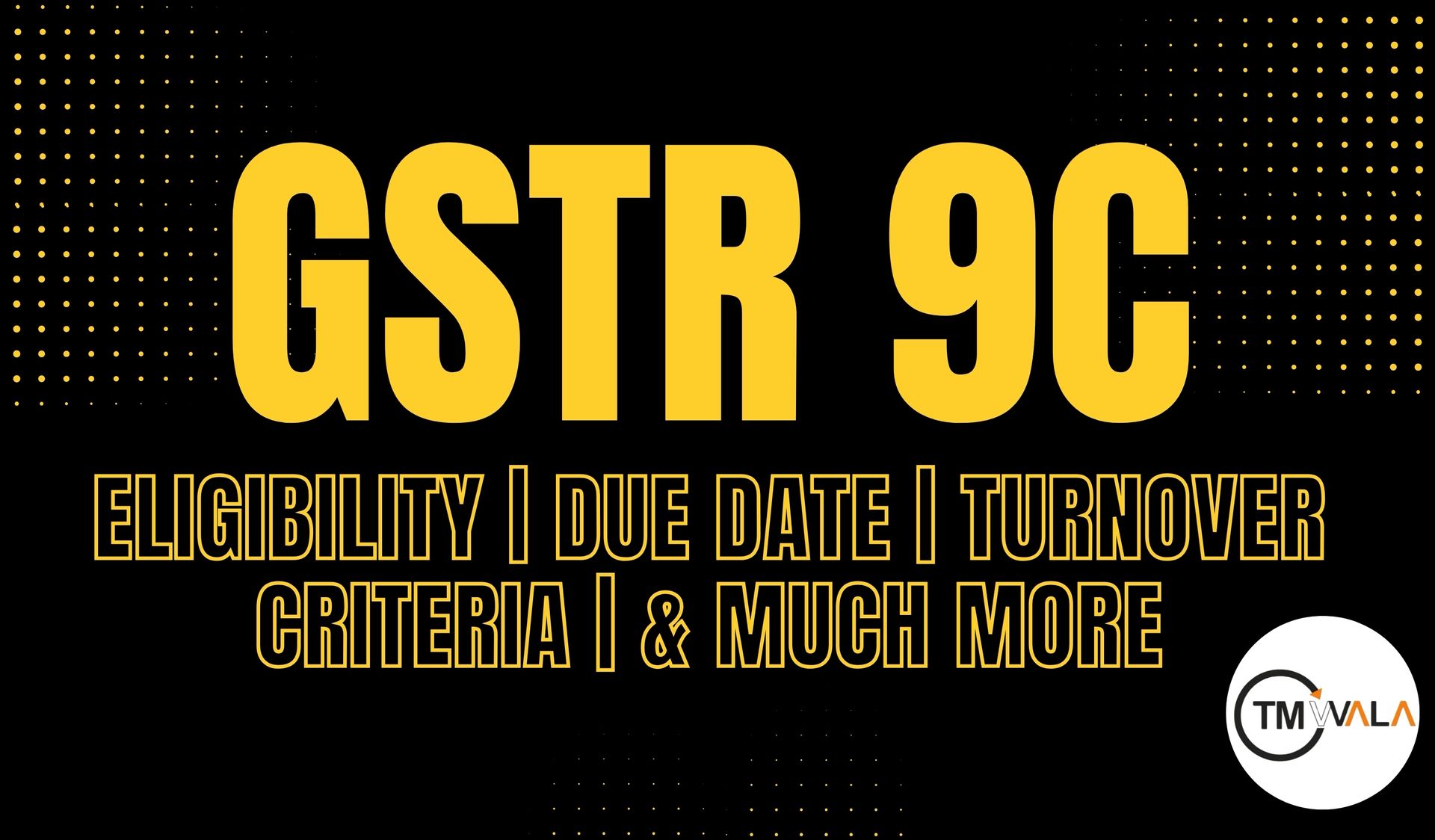
INTRODUCTION
GSTR 9C is a crucial compliance form under the Goods and Services Tax (GST) regime in India. It is a reconciliation statement filed annually by taxpayers whose turnover exceeds a specified limit. This form reconciles the details declared in GSTR-9 (Annual Return) with the audited financial statements of the taxpayer for the relevant financial year.
The form is essentially a self-certified statement (or certified by a Chartered Accountant or Cost Accountant for earlier years), highlighting any differences between GST filings and books of accounts. Its purpose is to ensure consistency, accuracy, and accountability in GST reporting.
With TMWala, businesses can track turnover thresholds across multiple GSTINs and prepare for GSTR-9C well before the deadline, minimizing last-minute compliance stress.
GSTR-9C must be filed by every registered taxpayer whose turnover in a fiscal year exceeds ₹5 crore. This eligibility criterion is determined based on aggregate turnover, calculated PAN-wise, across all registrations held by a person throughout India.
Aggregate turnover includes:
It excludes GST tax components like CGST, SGST, IGST, UTGST, and cess. If your aggregate turnover crosses ₹5 crore in a financial year, you are eligible and obligated to file GSTR-9C for each GSTIN you hold.
GSTR 9C reconciles the numbers from a taxpayer’s audited financial report with the GSTR annual returns for a fiscal year. It was introduced on 13th September 2018 as part of the government’s drive for transparent tax compliance. Filing GSTR-9C ensures discrepancies between GST returns and financial records are explained and corrected.
According to CBIC Notification No. 30/2021 dated July 30, 2021, and Rule 80 of the CGST Rules, registered persons under GST whose total turnover exceeds ₹5 crore in a fiscal year are required to file GSTR-9C. Read the Notice here: notfctn-30-central-tax-english-2021.pdf
Exceptions to applicability include:
TMWala helps in identifying exemptions and eligibility based on your business profile, saving time and ensuring only applicable forms are filed.
The due date for filing GSTR-9C is on or before 31st December of the subsequent financial year. This is the same as the deadline for filing the GSTR-9 (Annual Return).
For instance, for the financial year 2023–24, the deadline to file GSTR-9C is 31st December 2024, unless an extension is notified by the government.
Delays in filing may attract penalties, so businesses are encouraged to stay proactive in maintaining their compliance calendar.
The GSTR-9C turnover limit has been raised to Rs. 5 crore for FY 2018-19, FY 2019-20, FY 2020-21, FY 2021-22, and FY 2022-23, based on CBIC notifications. This means only those businesses with an annual aggregate turnover above ₹5 crore in a financial year are required to submit this form.
The turnover threshold is PAN-based, so even if individual GSTINs have lower turnovers, all GST registrations under a PAN must file GSTR-9C if the combined turnover exceeds ₹5 crore.
To restate the requirement, GSTR-9C must be filed by each registered taxpayer whose turnover exceeds ₹5 crore in a fiscal year.
This includes:
Each GSTIN must file a separate GSTR-9C return, regardless of individual turnover, if the overall PAN-based turnover crosses the threshold.
The GSTR-9C form is a crucial part of the GST annual return filing process for businesses in India. It supports and supplements GSTR-9, which is a comprehensive summary of:
While GSTR-9 provides data, GSTR-9C reconciles it with the financial records, helping the authorities verify that the taxpayer’s compliance aligns with audited books of accounts.
Although GSTR-9 and GSTR-9C are often filed together, they serve different purposes:
In short, GSTR-9 is data-driven, while GSTR-9C is audit- and compliance-driven.
Tools like TMWala’s real-time reconciliation dashboard make this verification process seamless, helping businesses avoid mismatches and audit red flags.
As of 2025, the GST audit limit in India is structured as follows:
The audit requirement stems from Section 35(5) of the CGST Act, which mandates reconciliation of GST returns with financial accounts for high-turnover taxpayers.
Filing GSTR-9C involves uploading a few essential documents to validate the reconciliation. These include:
These records aid in verifying the stated figures and offer clarity throughout the reconciliation procedure.
Filing GSTR-9C on the GST Portal can be done by following these simple steps:
Step 1: Log in to the GST Portal
Go to www.gst.gov.in and enter your GSTIN and password to log in.
Step 2: Access the ‘Annual Return’ Section
From the dashboard, navigate to Services > Returns > Annual Return.
Step 3: Select Financial Year
Select the fiscal year that you are submitting your GSTR-9C.
Step 4: File GSTR-9 First
Make sure you have successfully filed GSTR-9 before proceeding. GSTR-9C cannot be filed without it.
Step 5: Select GSTR-9C Form
Click on GSTR-9C and begin filling in the reconciliation details, such as:
Step 6: Upload Required Documents
Attach audited financial statements and audit reports. Ensure all documents are self-certified or digitally signed as required.
Step 7: Verify and Submit
Review the data carefully, verify using DSC or EVC, and submit the form.
Step 8: Save the Acknowledgment
Download and save the Acknowledgment Receipt for your records. It acts as proof of successful submission.
TMWala guides users through each filing step with checklists and prompts, reducing the risk of error or oversight during portal navigation.
GSTR-9C plays a pivotal role in India’s GST compliance system. With strict rules around eligibility, applicability, and turnover thresholds, taxpayers need to stay updated and ensure accurate reconciliation each year. Whether you handle your taxes or work with a GST practitioner, understanding GSTR-9C requirements can help you stay on the right side of compliance and avoid penalties or audit triggers down the road.
Get started instantly

TMWala
Your one stop shop for all your business registration and compliance needs.
Choose your Entity Type
Non-MSME/ Large Entitie
Individual/ MSME/ Sole Proprietorships

₹9,000.00 Original price was: ₹9,000.00.₹3,999.00Current price is: ₹3,999.00.
Trademark Application @ ₹3999* (Premium Discounted Plan for MSME/Individual/Sole Proprietorships) Comprehensive
Government Fees
₹4500/-

₹9,000.00 Original price was: ₹9,000.00.₹3,999.00Current price is: ₹3,999.00.
Trademark Application @ ₹3999* (Premium Discounted Plan for Non-MSMEs/Large Entities) Comprehensive
Government Fees
₹9000/-
Choose your Entity Type
Individual/ MSME/ Sole Proprietorships
Non-MSME/ Large Entities
₹3,500.00 Original price was: ₹3,500.00.₹1,999.00Current price is: ₹1,999.00.
Government Fees
₹4500/-
₹3,500.00 Original price was: ₹3,500.00.₹1,999.00Current price is: ₹1,999.00.
Government Fees
₹9000/-
Choose your Entity Type
Individual/ MSME/ Sole Proprietorships
Non-MSME/ Large Entities

₹1,500.00 Original price was: ₹1,500.00.₹999.00Current price is: ₹999.00.
Trademark Application @ ₹999* (Basic Discounted Plan for MSME/Individual/Sole Proprietorships) Best-Selling, Economical & Easy

₹1,500.00 Original price was: ₹1,500.00.₹999.00Current price is: ₹999.00.
Trademark Application @ ₹999* (Basic Discounted Plan for Non-MSMEs/Large Entities) Best-Selling, Economical, Quick and Easy